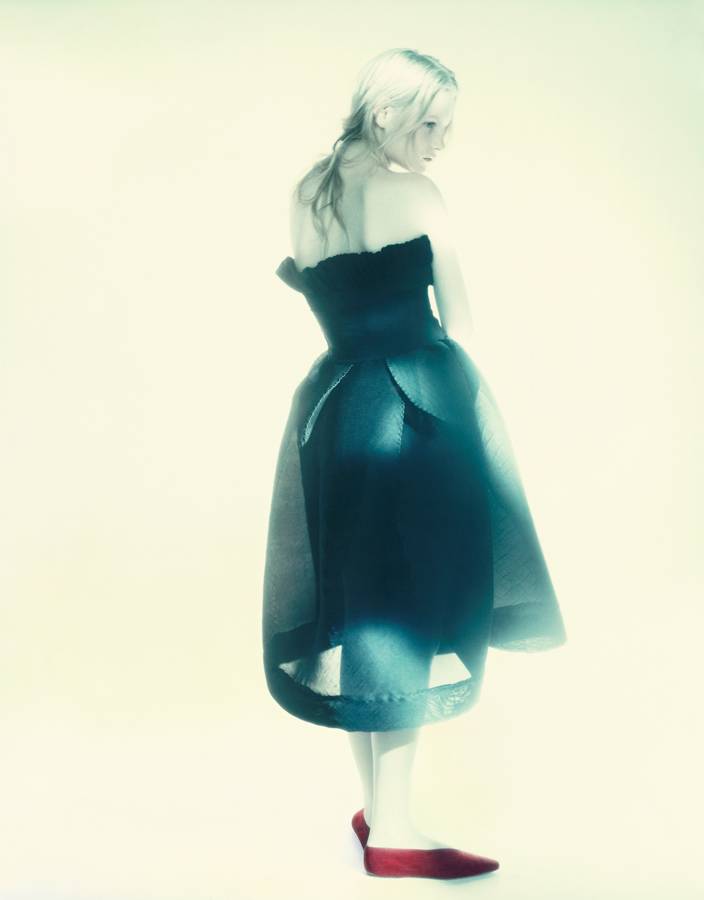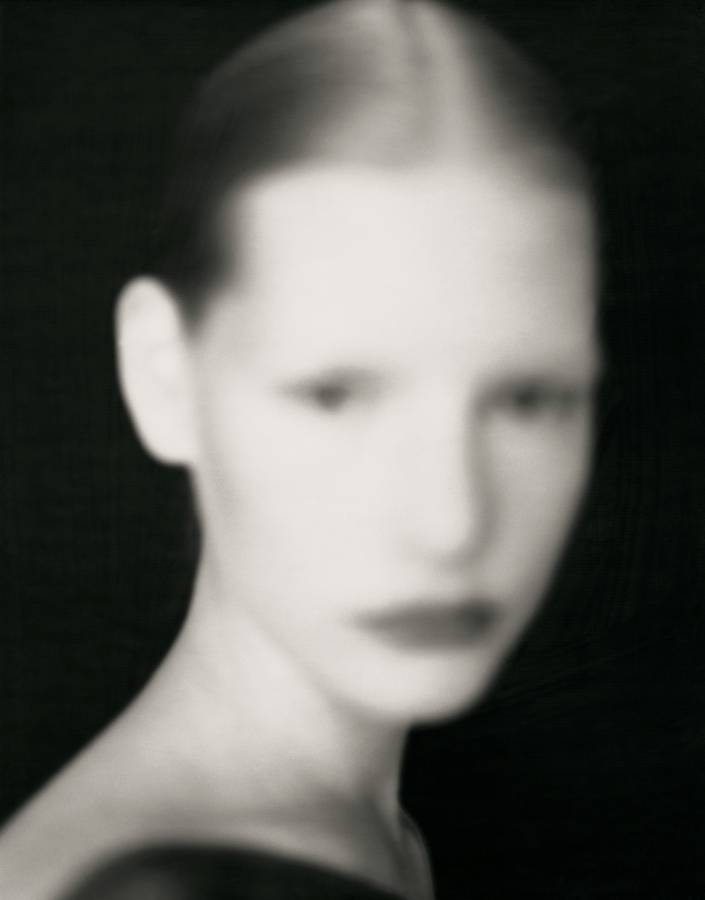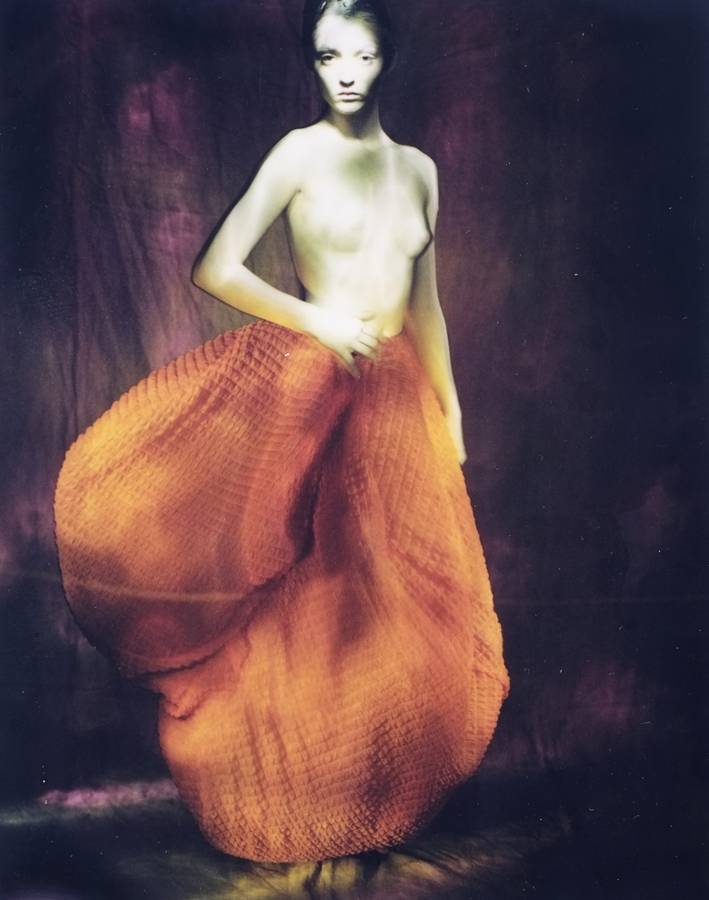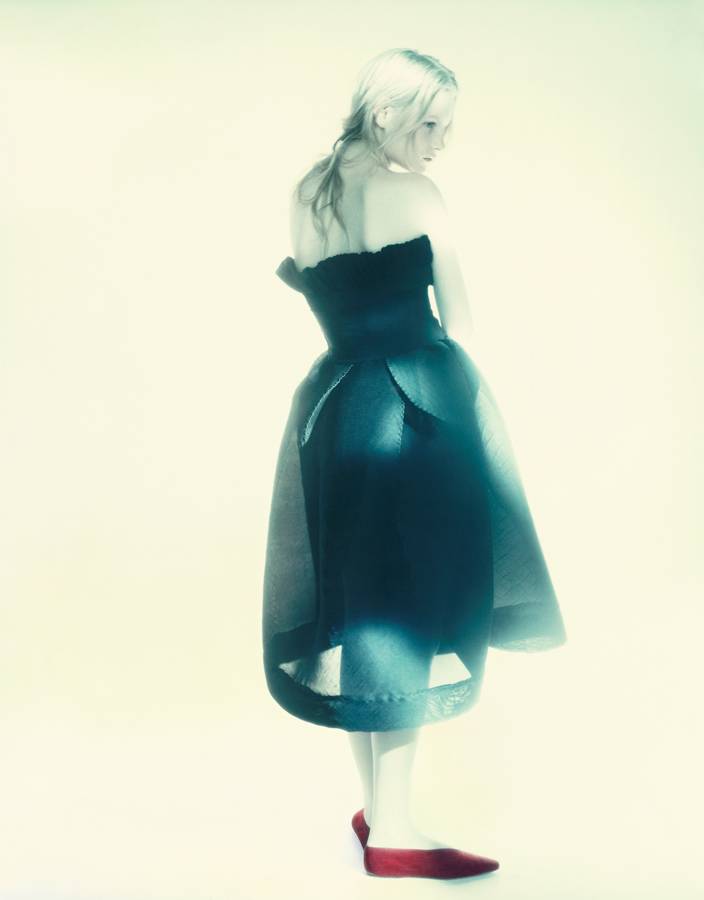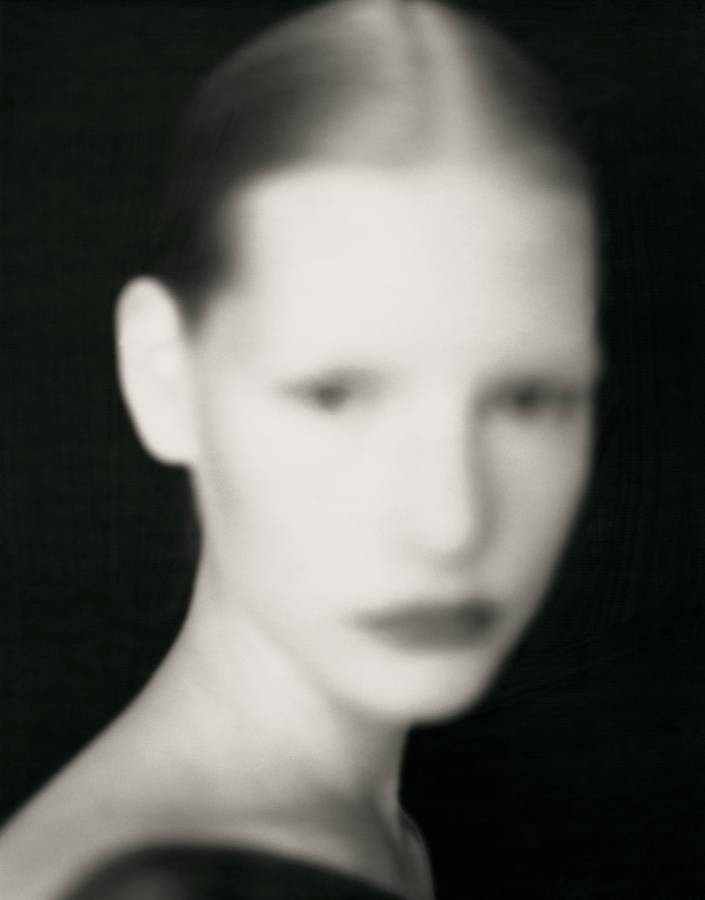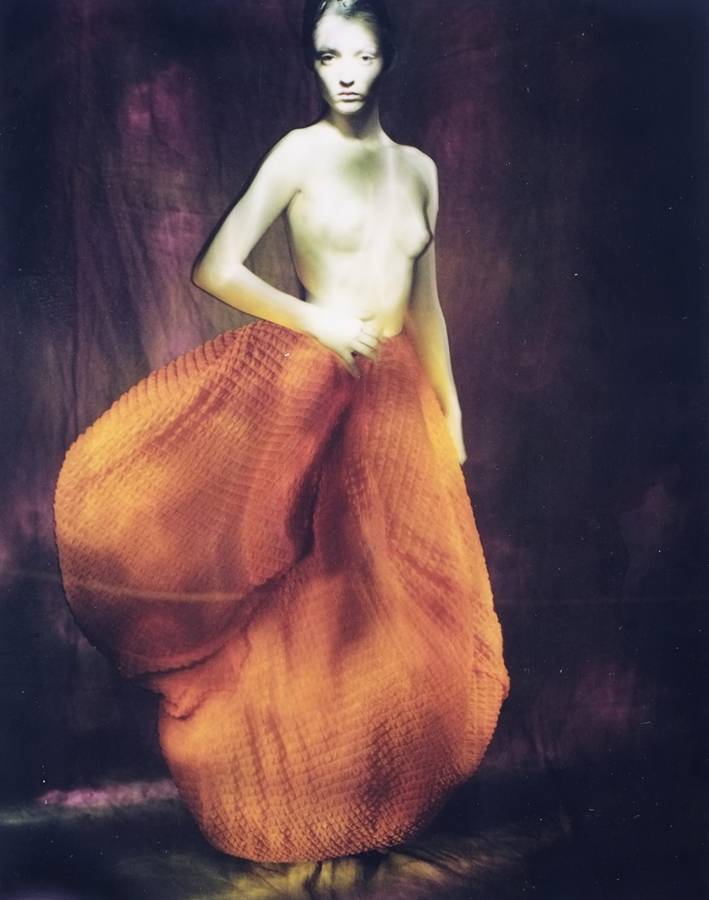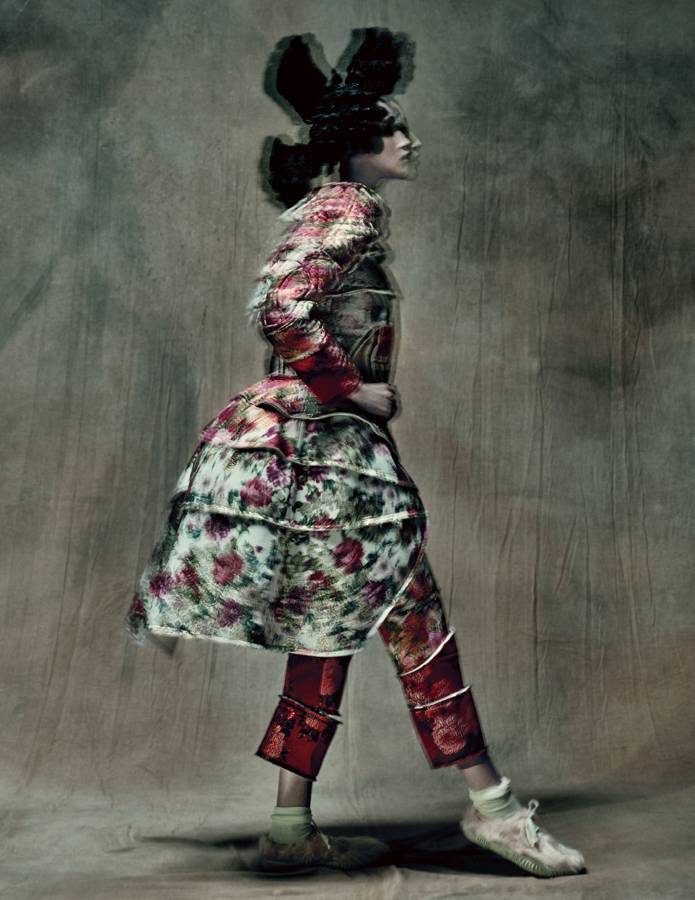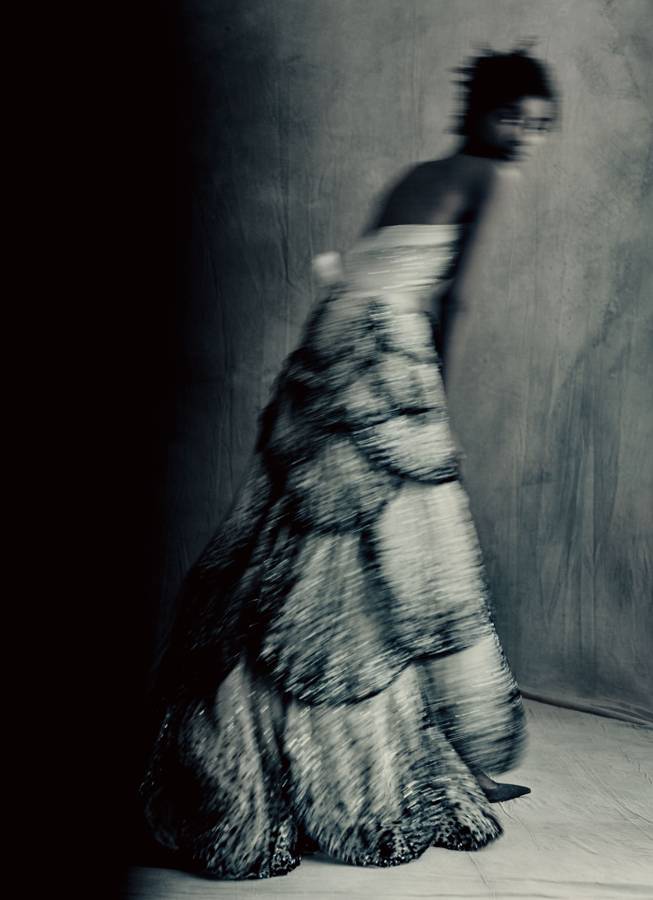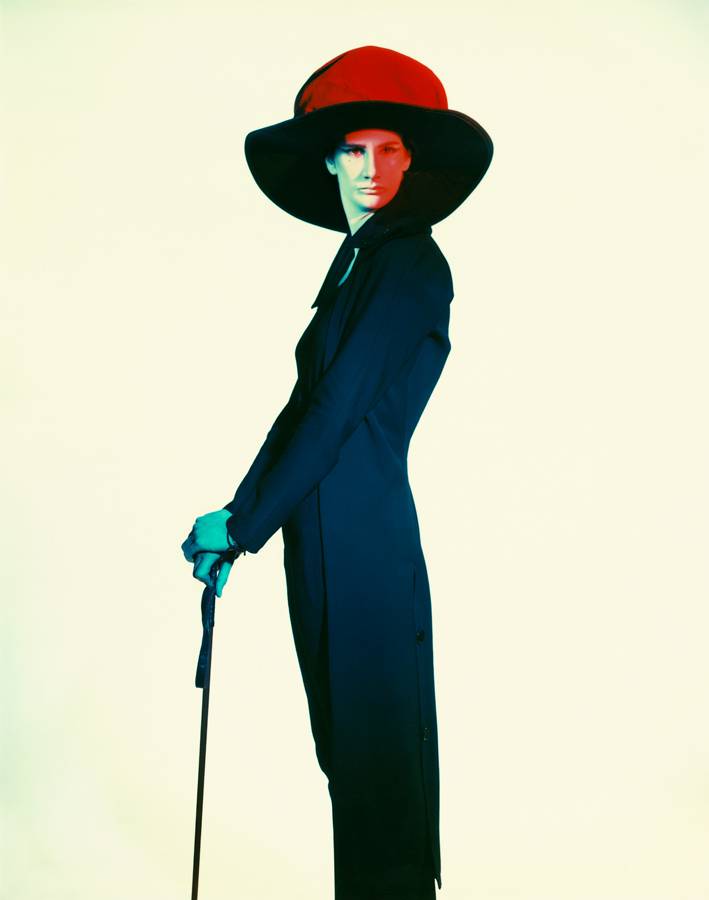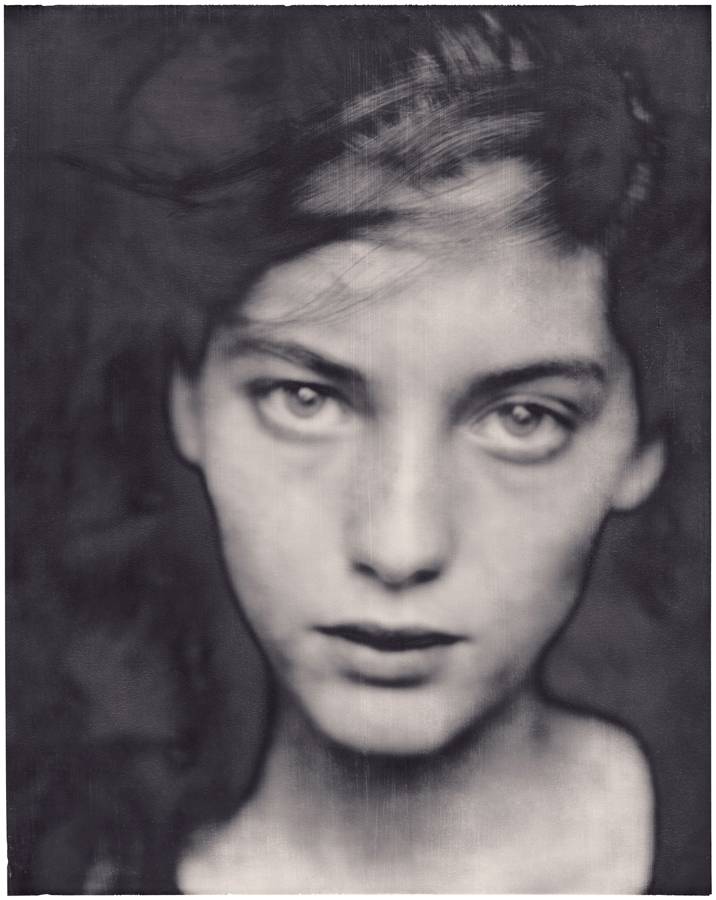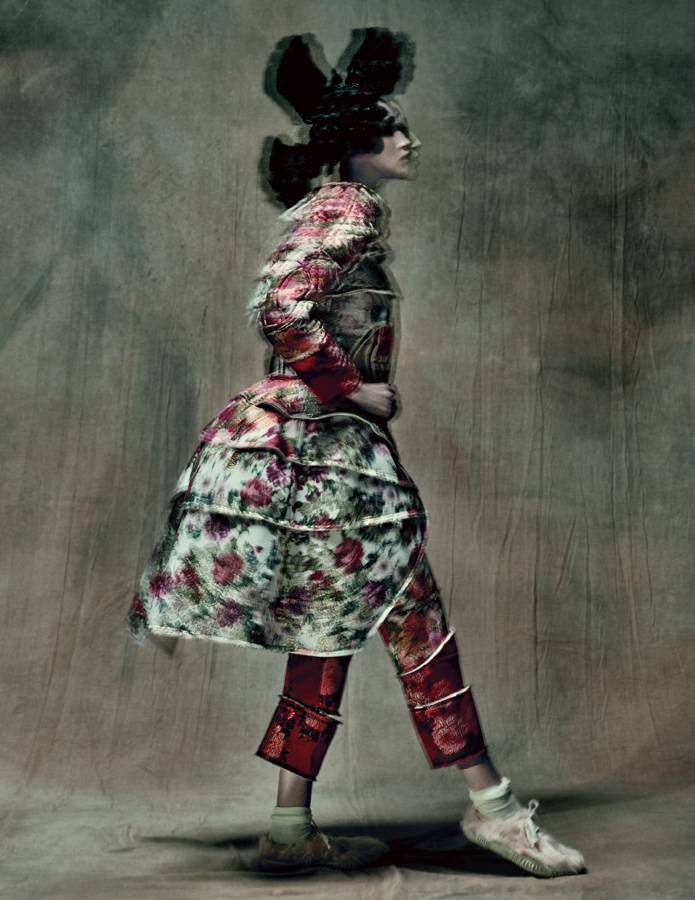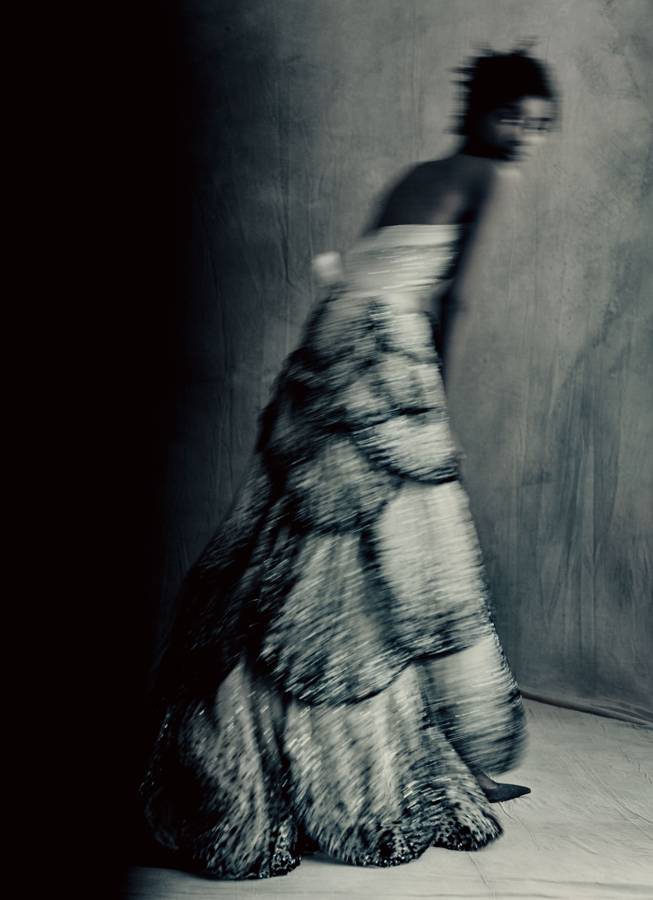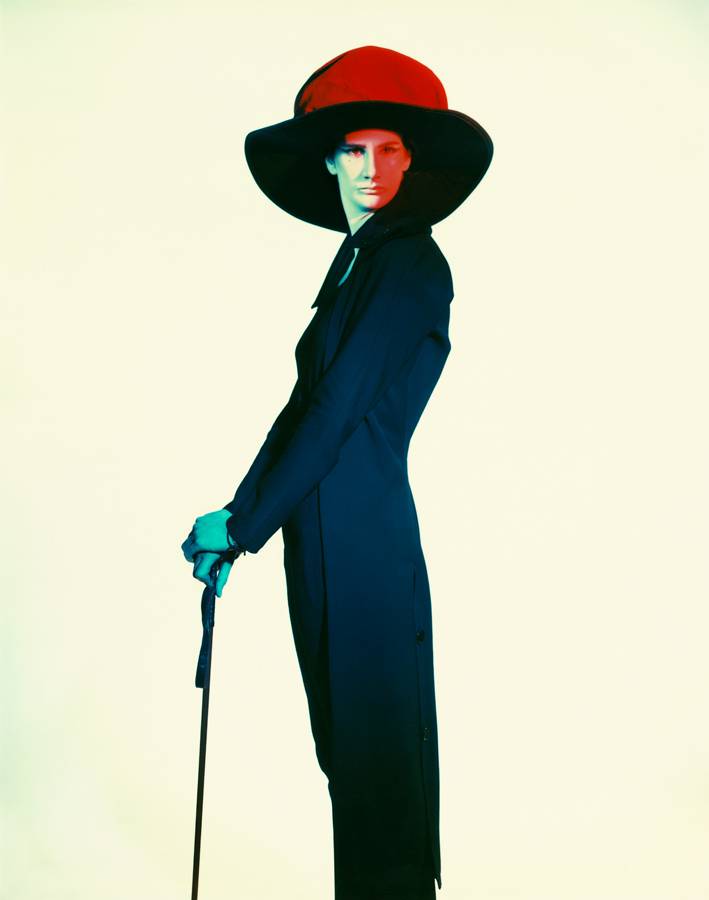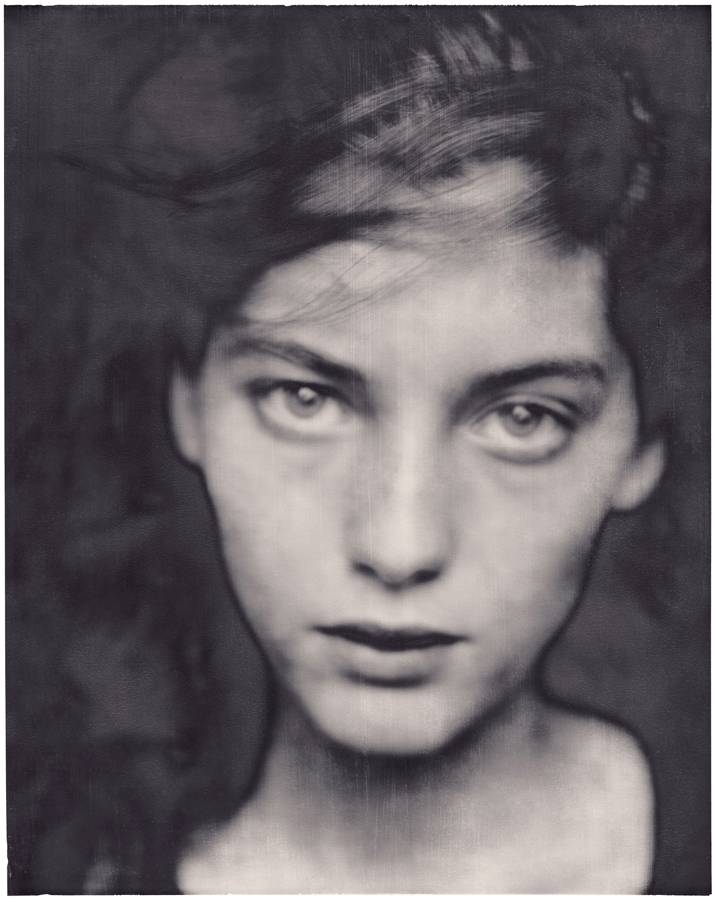Paolo Roversi goes behind the scenes of his sublime exhibition at the Palais Galliera
Le Palais Galliera consacre à l’immense photographe sa première exposition monographique à Paris. Au fil de 140 œuvres exceptionnelles, dont des inédites, le public est invité à parcourir cinquante années de travail d’un artiste à la sensibilité unique. Rencontre.
by Delphine Roche,
by Delphine Roche.
Featuring never-seen work, the photographer’s first Parisian solo show takes visitors on a journey through his extraordinary five-decade career. Curated by the Palais Galliera, the exhibition traces the rise of a fashion photographer with a unique sensibility.
Over 140 exceptional shots – both prints and Polaroids selected from his archives – demonstrate the full range of his collaborations with prestigious magazines. Thanks to his aesthete’s gaze, each image is infused with a melancholy grace whose poetry goes beyond trends and reaches for posterity.
Paolo Roversi at the Palais Galliera
He is not, strictly speaking, a fashion photographer. Since moving to Paris, in 1973, Paolo Roversi has built up an œuvre with and through fashion, capturing, beneath all the industry’s noise and agitation, a melancholy poetry that imprints itself on the memory.
As curated by the Palais Galliera, this first Parisian retrospective of his work underlines his total commitment to a personal necessity, an indefatigable search for beauty involving no pre-established method or recipe. Preparation for the show began before, and was delayed by, COVID-19, during which time it was in search of a title; in the end, its curators decided not to bother with one.
“It could have been called A Story Without a Narrative Thread, says Roversi, “because, like my work, there’s no red thread that weaves through it. Sylvie Lécallier and I went through my archives, took the time to think things through together, and chose a certain number of images that we decided not to organize chronologically.”
Depuis le 16 mars 2024, le Palais Galliera consacre à l’immense photographe sa première exposition monographique à Paris. Au fil de 140 œuvres exceptionnelles, dont certaines inédites, le public est invité à parcourir cinquante années de travail d’un artiste à la sensibilité unique.
Un voyage émouvant parmi ses tirages Polaroid et des archives issues de ses collaborations avec de prestigieux magazines, dévoilant l’ascension d’un photographe au regard d’esthète, qui a su infuser, dans chacune de ses images, une grâce mélancolique et une poésie ayant permis à ses clichés de traverser le temps pour s’inscrire dans l’éternité.
Paolo Roversi s’expose au Palais Galliera
Depuis son installation à Paris en 1973, Paolo Roversi a construit son œuvre, avec ou à travers la mode, en saisissant, sous le bruit, l’agitation et l’éphémère qui la caractérisent, une poésie et une mélancolie capables de s’inscrire durablement dans les mémoires.
Dans son organisation même, l’exposition que lui consacre jusqu’au 14 juillet le Palais Galliera souligne cet engagement absolu de l’artiste envers une nécessité intérieure, une recherche personnelle du beau sans recette ni méthode.
Entamée avant la pandémie et les bouleversements et retards qu’elle a entraînés, la préparation de cette monographie s’est ainsi longtemps cherché un titre, pour finalement ne pas en adopter.
“Elle aurait pu s’appeler Une histoire sans fil, commente Paolo Roversi, car à l’instar de mon travail, elle n’a pas de fil conducteur. La curatrice Sylvie Lécallier et moi avons passé en revue mes archives, nous avons pris le temps de discuter, et nous avons choisi un certain nombre d’images sans volonté de les classer chronologiquement.”
Featuring never-seen work, the photographer’s first Parisian solo show takes visitors on a journey through his extraordinary five-decade career. Curated by the Palais Galliera, the exhibition traces the rise of a fashion photographer with a unique sensibility.
Over 140 exceptional shots – both prints and Polaroids selected from his archives – demonstrate the full range of his collaborations with prestigious magazines. Thanks to his aesthete’s gaze, each image is infused with a melancholy grace whose poetry goes beyond trends and reaches for posterity.
Paolo Roversi at the Palais Galliera
He is not, strictly speaking, a fashion photographer. Since moving to Paris, in 1973, Paolo Roversi has built up an œuvre with and through fashion, capturing, beneath all the industry’s noise and agitation, a melancholy poetry that imprints itself on the memory.
As curated by the Palais Galliera, this first Parisian retrospective of his work underlines his total commitment to a personal necessity, an indefatigable search for beauty involving no pre-established method or recipe. Preparation for the show began before, and was delayed by, COVID-19, during which time it was in search of a title; in the end, its curators decided not to bother with one.
“It could have been called A Story Without a Narrative Thread, says Roversi, “because, like my work, there’s no red thread that weaves through it. Sylvie Lécallier and I went through my archives, took the time to think things through together, and chose a certain number of images that we decided not to organize chronologically.”
Depuis le 16 mars 2024, le Palais Galliera consacre à l’immense photographe sa première exposition monographique à Paris. Au fil de 140 œuvres exceptionnelles, dont certaines inédites, le public est invité à parcourir cinquante années de travail d’un artiste à la sensibilité unique.
Un voyage émouvant parmi ses tirages Polaroid et des archives issues de ses collaborations avec de prestigieux magazines, dévoilant l’ascension d’un photographe au regard d’esthète, qui a su infuser, dans chacune de ses images, une grâce mélancolique et une poésie ayant permis à ses clichés de traverser le temps pour s’inscrire dans l’éternité.
Paolo Roversi s’expose au Palais Galliera
Depuis son installation à Paris en 1973, Paolo Roversi a construit son œuvre, avec ou à travers la mode, en saisissant, sous le bruit, l’agitation et l’éphémère qui la caractérisent, une poésie et une mélancolie capables de s’inscrire durablement dans les mémoires.
Dans son organisation même, l’exposition que lui consacre jusqu’au 14 juillet le Palais Galliera souligne cet engagement absolu de l’artiste envers une nécessité intérieure, une recherche personnelle du beau sans recette ni méthode.
Entamée avant la pandémie et les bouleversements et retards qu’elle a entraînés, la préparation de cette monographie s’est ainsi longtemps cherché un titre, pour finalement ne pas en adopter.
“Elle aurait pu s’appeler Une histoire sans fil, commente Paolo Roversi, car à l’instar de mon travail, elle n’a pas de fil conducteur. La curatrice Sylvie Lécallier et moi avons passé en revue mes archives, nous avons pris le temps de discuter, et nous avons choisi un certain nombre d’images sans volonté de les classer chronologiquement.”
Fashion photography between abstraction and poetry
Setting out to give space to the emotions triggered by the photographs, and seeking to avoid smothering them with too much pedagogy or narration, Lécallier’s curation allows a specificity of Roversi’s work to emerge without labouring the point. “Mixing different periods of his work brings out the timeless character of his photographs,” she explains.
“Some of them look like they could have been taken in the 19th century, others now. The fact that his images are so hard to date is a real paradox in the context of fashion.” Roversi’s sensibility acts like a sort of abstraction of the present.
An admirer of the 19th-century portraitist Julia Margaret Cameron, whose melancholy female faces strike us with their eternal beauty, but also of Diane Arbus, who celebrated vulnerable freaks and marginals in her black-and-white prints, Roversi has created his own idiosyncratic world where the urgency and hysteria of fashion recede of their own accord.
I like ambiguity, and I walk the line that separates the masculine and the feminine, and shadow and light, looking for beauty” Paolo Roversi
At his studio in Paris’s 14th arrondissement, he works to the slow time imposed by large-format chamber cameras, and for many years used Polaroids – before transposing his vision to digital technology – which wash out the colours and attenuate the contrasts in black and white.
Where Richard Avedon or Irving Penn developed a signature lighting style, Roversi is constantly reinventing his, welcoming accidents and creating his own palette of pictorial colour that is entirely detached from realism.
“I like ambiguity, and I walk the line that separates the masculine and the feminine, and shadow and light, looking for beauty. I find it; I lose it; I approach it; then I step away. To my eyes, beauty remains mysterious, and I like it that way.”
Roversi’s work – the œuvre of a poet as much as a photographer – remains ineffably fascinating, a life force that has travelled intact through 50 years of fashion.
Paolo Roversi, Palais Galliera, Paris, 16 March–14 July, www.palaisgalliera.paris.fr
Des photos de mode entre abstraction et poésie
Donner de l’espace aux émotions que suscitent les photographies, éviter de les étouffer par trop de pédagogie ou de narration : le cahier des charges que s’est donné Sylvie Lécallier permet de faire affleurer, sans la souligner, une spécificité de l’œuvre de Paolo Roversi.
“Mêler différentes époques de son travail met en évidence le caractère intemporel de ses photographies. Certaines pourraient avoir été prises au XIXe siècle, ou au contraire à l’époque contemporaine. Le fait que ses images ne soient pas datables est un véritable paradoxe dans le contexte de la mode.”
La sensibilité de Paolo Roversi agit comme une sorte d’abstraction sur le présent qui se tient devant lui. Admirateur de la portraitiste du XIXe siècle Julia Margaret Cameron, qui a fixé pour l’éternité la beauté mélancolique de tant de visages féminins, mais aussi de Diane Arbus, qui a sublimé l’étrangeté et la vulnérabilité dans ses images en noir et blanc, Paolo Roversi a créé son propre monde, où l’urgence et l’hystérie de la mode s’effacent d’elles-mêmes.
J’aime l’ambiguïté, et je marche sur une ligne qui sépare le masculin du féminin et la lumière de l’ombre, à la recherche de la beauté” Paolo Roversi
Dans son studio du XIVe arrondissement, il opère au rythme lent dicté par la chambre photographique grand format, et travaille très longtemps au Polaroid – avant de transposer son écriture à la photo numérique –, qui délave les couleurs et atténue les contrastes du noir et blanc.
Alors que Richard Avedon et Irving Penn ont pratiqué avec une seule et même lumière devenue leur signature, Paolo Roversi réinvente sans cesse la sienne à partir de la boîte noire qu’est son studio, accueille les accidents et crée sa propre palette de couleurs picturales, détachées du réalisme.
“J’aime l’ambiguïté, et je marche sur une ligne qui sépare le masculin du féminin et la lumière de l’ombre, à la recherche de la beauté : je la touche, je la perds, je m’en approche et je m’en éloigne. À mes yeux, elle reste encore aujourd’hui mystérieuse, et c’est ce qui me plaît.”
L’œuvre de Paolo Roversi, poète autant que photographe, reste elle-même fascinante et ineffable, tel un courant de vie traversant intact plusieurs décennies de l’industrie de la mode.
L’exposition Paolo Roversi, du 16 mars 2024 au 14 juillet 2024 au Palais Galliera, musée de la Mode de Paris. 10, Avenue Pierre Ier de Serbie, Paris 16e.
Fashion photography between abstraction and poetry
Setting out to give space to the emotions triggered by the photographs, and seeking to avoid smothering them with too much pedagogy or narration, Lécallier’s curation allows a specificity of Roversi’s work to emerge without labouring the point. “Mixing different periods of his work brings out the timeless character of his photographs,” she explains.
“Some of them look like they could have been taken in the 19th century, others now. The fact that his images are so hard to date is a real paradox in the context of fashion.” Roversi’s sensibility acts like a sort of abstraction of the present.
An admirer of the 19th-century portraitist Julia Margaret Cameron, whose melancholy female faces strike us with their eternal beauty, but also of Diane Arbus, who celebrated vulnerable freaks and marginals in her black-and-white prints, Roversi has created his own idiosyncratic world where the urgency and hysteria of fashion recede of their own accord.
I like ambiguity, and I walk the line that separates the masculine and the feminine, and shadow and light, looking for beauty” Paolo Roversi
At his studio in Paris’s 14th arrondissement, he works to the slow time imposed by large-format chamber cameras, and for many years used Polaroids – before transposing his vision to digital technology – which wash out the colours and attenuate the contrasts in black and white.
Where Richard Avedon or Irving Penn developed a signature lighting style, Roversi is constantly reinventing his, welcoming accidents and creating his own palette of pictorial colour that is entirely detached from realism.
“I like ambiguity, and I walk the line that separates the masculine and the feminine, and shadow and light, looking for beauty. I find it; I lose it; I approach it; then I step away. To my eyes, beauty remains mysterious, and I like it that way.”
Roversi’s work – the œuvre of a poet as much as a photographer – remains ineffably fascinating, a life force that has travelled intact through 50 years of fashion.
Paolo Roversi, Palais Galliera, Paris, 16 March–14 July, www.palaisgalliera.paris.fr
Des photos de mode entre abstraction et poésie
Donner de l’espace aux émotions que suscitent les photographies, éviter de les étouffer par trop de pédagogie ou de narration : le cahier des charges que s’est donné Sylvie Lécallier permet de faire affleurer, sans la souligner, une spécificité de l’œuvre de Paolo Roversi.
“Mêler différentes époques de son travail met en évidence le caractère intemporel de ses photographies. Certaines pourraient avoir été prises au XIXe siècle, ou au contraire à l’époque contemporaine. Le fait que ses images ne soient pas datables est un véritable paradoxe dans le contexte de la mode.”
La sensibilité de Paolo Roversi agit comme une sorte d’abstraction sur le présent qui se tient devant lui. Admirateur de la portraitiste du XIXe siècle Julia Margaret Cameron, qui a fixé pour l’éternité la beauté mélancolique de tant de visages féminins, mais aussi de Diane Arbus, qui a sublimé l’étrangeté et la vulnérabilité dans ses images en noir et blanc, Paolo Roversi a créé son propre monde, où l’urgence et l’hystérie de la mode s’effacent d’elles-mêmes.
J’aime l’ambiguïté, et je marche sur une ligne qui sépare le masculin du féminin et la lumière de l’ombre, à la recherche de la beauté” Paolo Roversi
Dans son studio du XIVe arrondissement, il opère au rythme lent dicté par la chambre photographique grand format, et travaille très longtemps au Polaroid – avant de transposer son écriture à la photo numérique –, qui délave les couleurs et atténue les contrastes du noir et blanc.
Alors que Richard Avedon et Irving Penn ont pratiqué avec une seule et même lumière devenue leur signature, Paolo Roversi réinvente sans cesse la sienne à partir de la boîte noire qu’est son studio, accueille les accidents et crée sa propre palette de couleurs picturales, détachées du réalisme.
“J’aime l’ambiguïté, et je marche sur une ligne qui sépare le masculin du féminin et la lumière de l’ombre, à la recherche de la beauté : je la touche, je la perds, je m’en approche et je m’en éloigne. À mes yeux, elle reste encore aujourd’hui mystérieuse, et c’est ce qui me plaît.”
L’œuvre de Paolo Roversi, poète autant que photographe, reste elle-même fascinante et ineffable, tel un courant de vie traversant intact plusieurs décennies de l’industrie de la mode.
L’exposition Paolo Roversi, du 16 mars 2024 au 14 juillet 2024 au Palais Galliera, musée de la Mode de Paris. 10, Avenue Pierre Ier de Serbie, Paris 16e.









